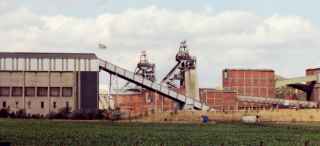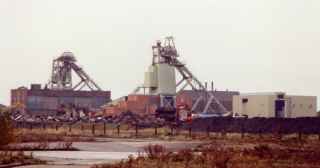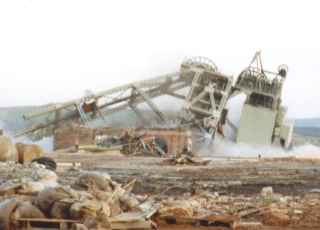The Nottingham Coalfield
(Adapted from an article by Len Quibell)
|
The further east the mining companies foraged, the deeper the mines, and Bevercotes (opened in the 1960s) and Harworth were among the deepest in Britain with shafts at 1,000 metres plus. |
|
Although Babbington Colliery at Cinderhill, Nottingham (sunk 1841), was the first site for serious coal mining in the county, Nottinghamshire was a relatively new coalfield compared to the other mining areas of Britain, and most of the larger mines were sunk after 1900.
With relatively new pits, Nottinghamshire was in the forefront of technological advancement in mining. Following the nationalisation of the coal industry in 1947, Nottinghamshire led the way in the mechanisation of coal production, the introduction of underground transport systems for both men and coal, and the replacement of pit ponies.
Thoresby Colliery � Stuart
Tomlins
|
Thoresby Colliery at Edwinstowe was the first all-electric mine, the first to have fully mechanised coal production and also the first to achieve an annual saleable output of more than a million tons. In the late 1980s it raised output to exceed two million tons. |
Calverton Colliery was the first new mine to be sunk in Britain after the second world war (starting production in the early 1950s) and was subsequently followed by the sinking of Bevercotes Colliery and Cotgrave collieries in the 1960s.
The 1960s and 1970s saw a mass migration of miners from closed coalfields in other parts of Britain - particularly the North-east and Scotland - to work in the expanding Nottinghamshire coalfield. Jock Purdon the pit poet of Northumbria wrote his famous Farewell To Cotia, about this migration "Leave ya picks behind you, you'll not need them again, off you go to Nottingham join Robins Merry Men."
|
To accommodate the northern immigrants, vast modern housing estates
were built by the then National Coal Board at Cotgrave, Calverton,
Ollerton, Forest Town and Clipstone. |
Ollerton �
Stuart Tomlins
|
With about 90% of the coalfield's output going to the electricity generating industry, Nottinghamshire pioneered the "merry-go-round train system'' where coal was taken from pit to power station in permanently coupled diesel hauled trains - loaded and unloaded on the move.
Heavy reliance on one major market also meant that constant high levels of production were the order of the day to ensure the continuation of the pits.
At its peak, the Nottinghamshire coalfield produced in excess of 25 million tons of coal in a year and more than half of the county's pits claimed a place in the industry's million-ton-a-year league.
While a few of the older pits closed in the 1960s it was in the late 1970s and 1980s that coal came under pressure , but at that time the power generators were linked to coal and ensured its bulk market. The attack on coals market was no natural progression , but a politically motivated assault aimed at weakening the shock troops of the Trade Union Movement in the shape of the NUM. The Unions could never be ruthlessly put under check while ever the NUM remained strategic and powerful with a grip on the nations major energy supply.
Nottinghamshire was at the heart of one of the darkest and most-violent episodes of British coal mining, when the industry came under the leadership of American coal owner Mr Ian MacGregor, appointed as chairman of British Coal in September, 1983.
The Bulk of the county's miners refused to join a national strike called by the NUM (National Union of Mineworkers) in March 1984, claiming it was unconstitutional. Although the fault lines for the splinter had been laid years before in the bitter dispute of 1926 and its aftermath.
Then Nottinghamshire miners joined in an anti miners organisation founded by Spencer, it led to bitter and often bloody battles for more than a decade and was only resolved, on the surface at least by the founding of the NUM and Nationalisation of the coal industry. In 84 as the NUM took on its most bitter battle for survival those fault lines re-emerged, fed and encouraged by government agents and a wilfully biased media.
It became a county under siege as thousands of miners from other coalfields arrived each day to picket the local mines. Under the direction of Mrs Margaret Thatcher's Tory government, police were drafted in from all over the country and by and large the vast majority of Nottinghamshire miners continued to work throughout the year-long dispute.
Ugly, pitched battles between police and pickets - it was not unusual to see 2,000 demonstrators outside a working colliery - were regular events and one Yorkshire miner died in a pithead demonstration at Ollerton Colliery.
A legacy of the strike, which ended in March 1985, was the formation that year of the Nottinghamshire based breakaway union of the UDM (Union of Democratic Mineworkers) .
Ollerton's final moments
� Stuart Tomlins
|
|
For the miners of Nottingham who had stood out on strike in the hardest battle of any area saying "we told you so" brought little satisfaction.
By 1997, just six collieries were still operating in private hands.
In addition to its major contribution to the industrial success of Britain, Nottinghamshire's coalfield has other claims to fame.
It produced many top class sportsmen, while colliery bands, pit heads and pit villages were featured in numerous films and television programmes.
Annesley Colliery near Kirkby-in-Ashfield, has a special place in cricket folklore.
At one time there were five men working underground who were destined to go on to play for England - including the legendary "bodyline'' pace-bowling partners, Harold Larwood and Bill Voce.
Hill Top - Kellingley - Longannet - Monument - Maltby -Phoenix and Hopewell - Prince of Wales - Rossington
The Free Miners - The Selby Complex - Thoresby -Thorne - Tower - Welbeck - The Nottingham Coalfield
Mining 2000 Conclusions



